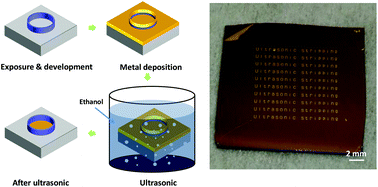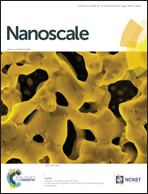An anti-ultrasonic-stripping effect in confined micro/nanoscale cavities and its applications for efficient multiscale metallic patterning†
Abstract
We report a method to reliably and efficiently fabricate high-fidelity metallic structures from a ten-nanometer to a millimeter scale based on an anti-ultrasonic-stripping (AUS) effect in confined micro/nanoscale cavities. With this AUS effect, metallic structures, which are surrounded by the pre-patterned closed templates, could be defined through selectively removing the evaporated metallic layer at the top and outside of the templates by ultrasonic-cavitation-induced stripping. Because only pre-patterned templates are required for exposure in this multiscale patterning process, this AUS-based process enables much smaller and more reliable plasmonic nanogaps due to the mitigated proximity effect and allows rapid fabrication of multiscale metallic structures which require both tiny and large structures. With unprecedented efficiency and resolution down to a ten-nanometer scale, various metallic structures were fabricated using this AUS-effect-based multiscale patterning process. This AUS effect paves the way for direct writing of metallic structures with a high resolution over a large area for practical applications in plasmonics and nanogap-based electronics.


 Please wait while we load your content...
Please wait while we load your content...